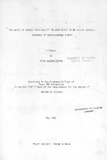| dc.description.abstract | Seasonal effect of bush canopy on dietary selection and nutrition
of goats was evaluated at Kiboko, south-central Kenya from June through
November, 1982. Three mature esophageally fistulated East-African goats
were used in the study on a one day graze, 28-30 day rest cycle. Treatment
paddocks (2.25 ha), twice replicated were established in three bush
conditions designated as light, moderate, and heavy with 13.1,30.7 and
46.8% total canopy cover, respectively.
Dietary habits of the goats reflected a high degree of seasonal
flexibility between forag~_~lasses, species and plant .parts. Grass and
grasslike species dominated goat diets in the early-dry period, particularly
Cencnrus ciliaris, Sporobolus pellucides, Eragrostis caespitosa,
Digitaria macroblephara and Chloris roxburghiana. Talinum portulacifolium,
which dominated the forb category, became an important component
in the diet composition in the early wet season. Overall, browse played
the most important role in the diets of goats mainly in the moderate and
heavy bushed treatment paddocks from August through November. Acacia
senegal pods were the major source of food for goats in July and August.
Grasses, forbs and woody species comprised 45%, 7% and 47% of goat diets
respectively throughout the study period. Leaves, stems and fruits
(seeds, pods and grass inflorescences) from all categories of vegetation
iv
were consumed by goats. However, leaves formed the greatest portion of,
the goat diets throughout the period of study.
Solanum incanum, Grewia bicolor, Acacia mellifera, Acacia senegal,
Cenc~~s ciliaris and Sporobolus pellucides were the most preferred
woody and grass species during the early-dry and late-dry seasons while
Talinum portulacifolium, Solanum incanum, Acacia mellifera, Commiphora
africana, Sporobolus pellucides and Chloris roxburghiana were the most
preferred vegetation species in the early-wet season.
Nutritional analysis of extrusa indicated that the goats were able t
to select diets adequate in protein to meet maintenance requirements
throughout the period of study. A potential energy deficiency for
maintenance was noted in moderate and heavy bushed conditions in August
and heavy bushed conditions in September. | en |

